NR-541: Practice of Nursing Informatics Course Assignments & Discussions Study Guide
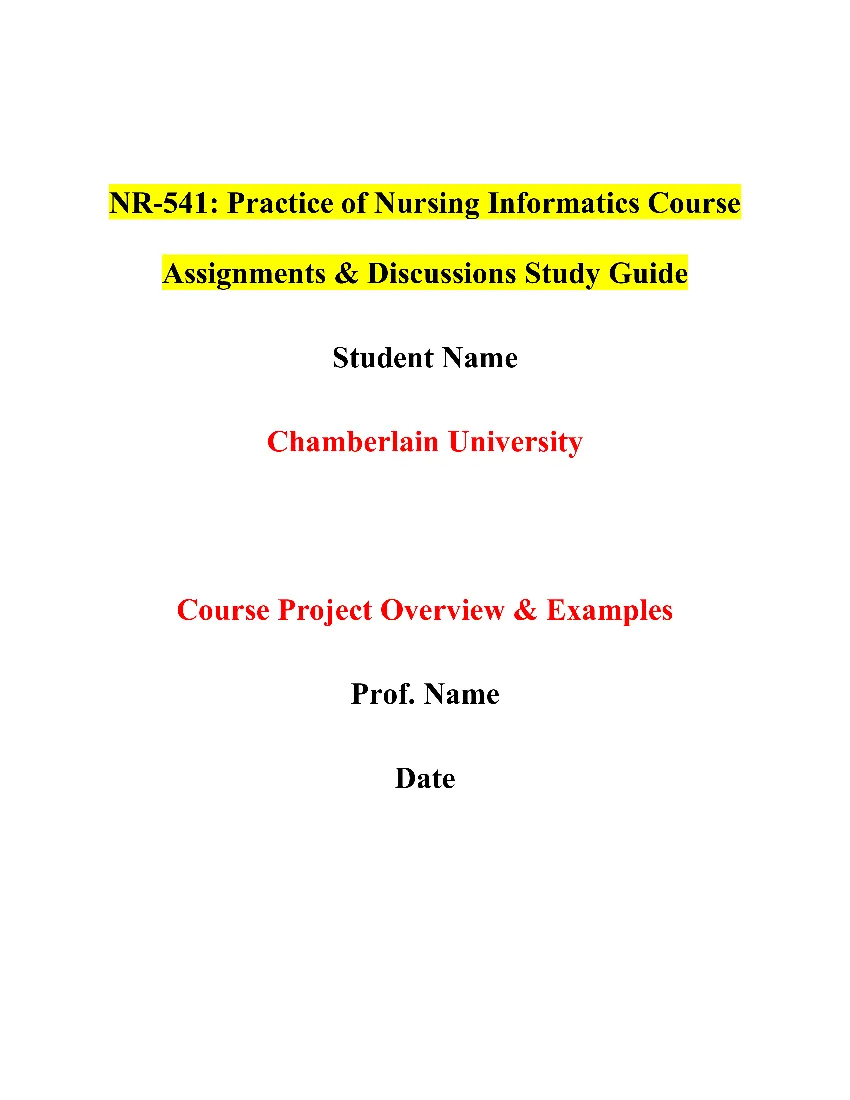 NR-541: Practice of Nursing Informatics Course Description
NR-541: Practice of Nursing Informatics Course Description
Contact Hours: Lecture – 48, Lab – 0, Clinical – 0
Semester Hours: Theory 3
In this course, the student examines the role, functions and scope and standards of practice of the informatics nurse. The student explores, analyzes, applies and evaluates diverse aspects of nursing-informatics practice as a specialization.
Prerequisites Effective January 2024:
NR-581 or NR-581NP, NR-582 or NR-582NP, NR-583 or NR-583NP, NR-584 or NR-584NP, NR-585 or NR-585NP, NR-586 or NR-586NP
Prerequisite: NR-500, NR-501, NR-504, NR-505, NR-506 or NR-544, NR-512
For top-quality coursework writing help and assignment writing services, trust Nursing Custom Writing. Our expert team delivers 100% original human-written work tailored to your needs. Contact us via phone, WhatsApp, or live chat for assistance today and get the most reliable research paper help!
NR-541: Practice of Nursing Informatics Course Syllabus
Discussion (Weeks 1, 2, 3,4, 5, 6, 7, and 8)
Self-Assessment (Week 1)
Interview with NI Practitioner (Week 2)
Position Description Analysis (Week 3)
Individual Development Plan (Week 4)
Network Presentation (Week 7)
Syllabus Overview
| Course Number: | NR541 |
| Course Title: | Practice of Nursing Informatics |
| Course Credits: | 3 credits |
| Prerequisite: | NR500, NR501, NR504, NR505, NR506, NR512 |
Course Description
This course introduces the student to the role, functions, and scope and standards of practice of the informatics nurse. Students will explore, analyze, apply, and evaluate diverse aspects of nursing-informatics practice as a specialization. Topics include the use and implementation of technology for virtual care delivery and monitoring, and complementary roles of the master’s-prepared informatics nurse specialist, and other information-technology professionals.
You can also read another study guide on nursing assignments for students from another post on NR-542: Managing Data and Information Course Assignments & Discussions.
Textbooks and Resources
Required Textbooks
Access E-Book McGonigle, D. & Mastrian, K. (2015). Nursing informatics and the foundation of knowledge (3rd ed.). Burlington, MA:Jones & Bartlett.
American Nurses Association (2015). Nursing informatics: Scope and standards of practice (2nd ed.). Silver Spring, MD: Author.
American Psychological Association. (2010). Publication manual of the American Psychological Association (6th ed.). Washington, DC: Author.
Physical Books and Supplies
To obtain all your books and supplies, visit the online Chamberlain bookstore at https://bookstore.chamberlain.edu/.
eBook Details
You must purchase your books through the bookstore before the eBook links above will function.
First Time Using VitalSource?
Step 1: View the VitalSource Video
Step 2: Register with VitalSource Bookshelf Online
- Click the cover or title of your eBook. A new window will open.
- Enter email address and password. Bookshelf Online will open.
Step 3: Access the Desktop and Mobile Versions
You must complete Step 2 prior to using the desktop or mobile versions.
Already Registered? 3 Ways to Access Your eBooks
Online
Access your eBook by clicking on the book cover or title in the syllabus page. Bookshelf Online will open.
Desktop
Download your eBooks and use them whether you’re connected to the Internet or not.
Mobile
Download the app and get your eBooks on your iPhone, iPad, or Android device.
Textbooks and Resources
Required Textbooks
The following books are required for this course:
Author, A. A., & Author, B. B. (year of publication). Title of textbook in italics (X ed.). City, ST: Publisher.
Information regarding supplementary material, software, etc.
The following book is required across all FNP courses:
American Psychological Association. (2010). Publication manual of the American Psychological Association (6th ed.). Washington, DC: Author.
The following book is recommended across all FNP courses:
Goroll, A. H., & Mulley, A. G. (2014). Primary care medicine: Office evaluation and management of the adult patient (7th ed.). China: Wolters Kluwer.
Physical Books and Supplies
To obtain all your books and supplies, visit the online Chamberlain bookstore at https://bookstore.chamberlain.edu/.
eBook Details
You must purchase your books through the bookstore before the eBook links above will function.
First Time Using VitalSource?
Step 1: View the VitalSource Video
Step 2: Register with VitalSource Bookshelf Online
- Click the cover or title of your eBook. A new window will open.
- Enter email address and password. Bookshelf Online will open.
Step 3: Access the Desktop and Mobile Versions
You must complete Step 2 prior to using the desktop or mobile versions.
Already Registered? 3 Ways to Access Your eBooks
Online
Access your eBook by clicking on the book cover or title in the syllabus page. Bookshelf Online will open.
Desktop
Download your eBooks and use them whether you’re connected to the Internet or not.
Mobile
Download the app and get your eBooks on your iPhone, iPad, or Android device.
Program Outcomes
Program Outcomes of Chamberlain nursing programs can be found in the Program Descriptions section of your College Catalog. You can access your College Catalog at http://www.chamberlain.edu/msncatalog.
The MSN program outcomes are aligned with the American Association of Colleges of Nursing publication, The Essentials of Master’s Education in Nursing (2011). Upon completion of the MSN degree program, the graduate will be able to:
- Practice safe, high-quality advanced nursing care based on concepts and knowledge from nursing and related disciplines.
- Construct processes for leading and promoting quality improvement and safety in advanced nursing practice and healthcare delivery.
- Use contemporary communication modalities effectively in advanced nursing roles.
- Evaluate the design, implementation and outcomes of strategies developed to meet healthcare needs.
- Develop a plan for lifelong personal and professional growth that integrates professional values regarding scholarship, service and global engagement.
- Apply legal, ethical and human-caring principles to situations in advanced nursing practice.
- Design patient-centered care models and delivery systems using the best available scientific evidence.
- Manage human, fiscal and physical resources to achieve and support individual and organizational goals.
- Compose a plan for systematic inquiry and dissemination of findings to support advanced nursing practice, patient-care innovation, and the nursing profession.
- Collaborate interprofessionally in research, education, practice, health policy and leadership to improve population health outcomes.
- Apply principles of informatics to manage data and information in order to support effective decision making.
Course Outcomes
Chamberlain College of Nursing courses are built to align course content with specific Course Outcomes (COs). The COs define the learning objectives that the student will be required to comprehend and demonstrate by course completion. The COs that will be covered in detail each week can be found in the Overview page in that particular week. Whenever possible, a reference will be made from a particular assignment or discussion back to the CO that it emphasizes.
Upon completion of this course, the student will be able to do the following.
- Synthesize knowledge and concepts from nursing informatics and supporting disciplines as a foundation for the practice of nursing informatics. (PO #1)
- Examine legal, regulatory, ethical, and accreditation issues in nursing-informatics practice. (PO #6)
- Incorporate the standards of practice for nursing informatics that exemplify professional values, scholarship, service, and global awareness. (PO #5)
- Apply critical inquiry and judgment to nursing informatics concepts models, supporting sciences, and information-technology applications. (PO #4)
Course Schedule
| Week, COs, and Topics | Readings | Assignments |
| Week 1
CO 1 The Specialty of Nursing Informatics (NI) |
McGonigle, D., & Mastrian, K. (2015). Nursing informatics and the foundation of knowledge (3rd ed.). Burlington, MA: Jones & Bartlett.
Advancing science, improving lives. Link to article American Nurses Association. (2015). Nursing informatics: Scope and standards of practice (2nd ed.). Silver Spring, MD: Author.
National Institute of Nursing Research. (2016). The NINR strategic plan: Advancing science, improving lives.Link to article Suggested Reading American Nurses Association (ANA). (2010a). Recognition of a nursing specialty, Approval of a specialty nursing scope of practice statement, and Acknowledgment of specialty nursing standards of practice. Link to article Finnell, D., Thomas, E., Nehring, W., McLoughlin, K., Bickford, C. (2015). Best practices for developing specialty nursing scope and standards of practice. OJIN: The Online Journal of Issues in Nursing, 20(2), Manuscript 1. Link to article |
Self-Assessment
Graded Discussion Quiz |
| Week 2
COs 1, 4 NI Functional Areas, Competencies, and Supporting Sciences |
McGonigle, D., & Mastrian, K. (2015). Nursing informatics and the foundation of knowledge (3rd ed.). Burlington, MA: Jones & Bartlett.
American Association of Colleges of Nursing. (2011). The essentials of master’s education in nursing.
American Nurses Association (2015). Nursing informatics: Scope and standards of practice (2nd ed.). Silver Spring, MD: Author.
National League for Nursing. (2015). Vision Series: A VISION FOR The Changing Faculty Role: Preparing Students for the Technological World of Health Care. Click here for link Technology Informatics Guiding Education Reform (TIGER) Initiative. (2007). Evidence and informatics transforming nursing: 3-year action steps toward a 10-year vision. Link to article |
Interview with NI Practitioner
Graded Discussion Quiz |
| Week 3
CO 3 NI Scope and Standards of Practice |
American Nurses Association (2015). Nursing informatics: Scope and standards of practice (2nd ed.). Silver Spring, MD: Author.
Anderson, C., & Sensmeier, J. (2015). A closer look at this specialty. Nursing Management, 46(6), 20-21.Link to article Bickford, C. J. (2015). The specialty of nursing informatics: New scope and standards guide practice. CIN: Computers, Informatics, Nursing, 33(4), 129. Link to article Harrington, L. (2015). Technology Today. American Nurses Association releases new scope and standards of nursing informatics practice. AACN Advanced Critical Care, 26(2), 93. Link to article |
Position Description Analysis
Graded Discussion Quiz |
| Week 4
CO 4 Virtual Healthcare |
McGonigle, D., & Mastrian, K. (2015). Nursing informatics and the foundation of knowledge (3rd ed.). Burlington, MA: Jones & Bartlett.
Bartz, C. C. (2014). Leadership strategies for improved nursing synergy between informatics and telehealth. Studies In Health Technology And Informatics,26(2), 93-96. Link to article |
Individual Development Plan
Graded Discussion Quiz |
| Week 5
CO 1 Healthcare Trends and NI Practice |
McGonigle, D., & Mastrian, K. (2015). Nursing informatics and the foundation of knowledge (3rd ed.). Burlington, MA: Jones & Bartlett
|
Graded Discussion
Quiz |
| Week 6
CO 2, 4 Issues in NI Practice |
McGonigle, D., & Mastrian, K. (2015). Nursing informatics and the foundation of knowledge (3rd ed.). Burlington, MA: Jones & Bartlett.
American Nurses Association. (2015). Code of ethics for nurses with interpretive statements. Silver Spring, MD: Nursebooks.org (students should note that this is available through the library R2Rittenhouse collection. Link to article American Nurses Association (2015). Nursing informatics: Scope and standards of practice (2nd ed.). Silver Spring, MD: Author.
|
Graded Discussion
Quiz |
| Week 7
COs 1, 4 Information Technology |
McGonigle, D., & Mastrian, K. (2015). Nursing informatics and the foundation of knowledge (3rd ed.). Burlington, MA: Jones & Bartlett.
Suggested Readings Hallberg, B. A. (2010). Networking : A Beginner’s Guide. New York: McGraw-Hill.
Barry, D. K. (2013). Web Services, Service-oriented Architectures, and Cloud Computing. San Francisco, Calif: Morgan Kaufmann.
|
Network Presentation
Graded Discussion Quiz |
| Week 8
COs 1, 4 Technical Standards |
McGonigle, D., & Mastrian, K. (2015). Nursing informatics and the foundation of knowledge (3rd ed.). Burlington, MA: Jones & Bartlett.
American Health Information Management Association (AHIMA). (2013). Data Standards, Data Quality, and Interoperability (AHIMA Practice Brief Updated). Link to article Suggested Readings Healthcare Information and Management Systems Society (HIMSS). (2013). What is Interoperability? Link here 2016 Interoperability Standards Advisory – 2016-interoperability-standards-advisory-final-508.pdf. (n.d.). Link here |
Graded Discussion
Quiz Final Exam |
Quizzes, tests, and exams are scheduled throughout this course – see the Assignments pages in the weeks they are given for the time and date they will be available.
Late Assignment Policy
Students are expected to submit assignments by the time they are due. Assignments submitted after the due date and time will receive a deduction of 10% of the total points possible for that assignment for each day the assignment is late. Assignments will be accepted, with penalty as described, up to a maximum of three days late, after which point a zero will be recorded for the assignment.
In the event of an emergency that prevents timely submission of an assignment, students may petition their instructor for a waiver of the late submission grade reduction. The instructor will review the student’s rationale for the request and make a determination based on the merits of the student’s appeal. Consideration of the student’s total course performance to date will be a contributing factor in the determination. Students should continue to attend class, actively participate, and complete other assignments while the appeal is pending.
This Policy applies to assignments that contribute to the numerical calculation of the course letter grade.
Evaluation Methods
The maximum score in this class is 1,000 points. The categories, which contribute to your final grade, are weighted as follows.
| Graded Item | Points | Weighting |
| Discussion (50 points, Weeks 1, 2 ; 25 points, Weeks 3,4, 5, 6, 7, and 8) | 250 | 25% |
| Self-Assessment (Week 1) | 50 | 5% |
| Interview with NI Practitioner (Week 2) | 150 | 15% |
| Position Description Analysis (Week 3) | 150 | 15% |
| Individual Development Plan (Week 4) | 150 | 15% |
| Network Presentation (Week 7) | 150 | 15%
|
| Quizzes ( Weeks 1–8) | 30 | 3% |
| Final Exam (Week 8) | 70 | 7% |
| Total | 1,000 | 100% |
No extra credit assignments are permitted for any reason.
All of your course requirements are graded using points. At the end of the course, the points are converted to a letter grade using the scale in the table below. Percentages of 0.5% or higher are not raised to the next whole number. A final grade of 76% (letter grade C) is required to pass the course.
| Letter Grade | Points | Percentage |
| A | 940–1,000 | 94% to 100% |
| A- | 920–939 | 92% to 93% |
| B+ | 890–919 | 89% to 91% |
| B | 860–889 | 86% to 88% |
| B- | 840–859 | 84% to 85% |
| C+ | 810–839 | 81% to 83% |
| C | 760–809 | 76% to 80% |
| F | 759 and below | 75% and below |
NOTE:To receive credit for a week’s discussion, students may begin posting no earlier than the Sunday immediately before each week opens. Unless otherwise specified, access to most weeks begins on Sunday at 12:01 a.m. MT, and that week’s assignments are due by the next Sunday by 11:59 p.m. MT. Week 8 opens at 12:01 a.m. MT Sunday and closes at 11:59 p.m. MT Wednesday. Any assignments and all discussion requirements must be completed by 11:59 p.m. MT Wednesday of the eighth week.
Students agree that, by taking this course, all required papers may be subject to submission for textual similarity review to Turnitin.com for the detection of plagiarism. All submitted papers will be included as source documents in the Turnitin.com reference database solely for the purpose of detecting plagiarism of such papers. Use of the Turnitin.com service is subject to the Terms and Conditions of Use posted on the Turnitin.com site.
Participation for MSN
Threaded Discussion Guiding Principles
The ideas and beliefs underpinning the threaded discussions (TDs) guide students through engaging dialogues as they achieve the desired learning outcomes/competencies associated with their course in a manner that empowers them to organize, integrate, apply and critically appraise their knowledge to their selected field of practice. The use of TDs provides students with opportunities to contribute level-appropriate knowledge and experience to the topic in a safe, caring, and fluid environment that models professional and social interaction. The TD’s ebb and flow is based upon the composition of student and faculty interaction in the quest for relevant scholarship. Participation in the TDs generates opportunities for students to actively engage in the written ideas of others by carefully reading, researching, reflecting, and responding to the contributions of their peers and course faculty. TDs foster the development of members into a community of learners as they share ideas and inquiries, consider perspectives that may be different from their own, and integrate knowledge from other disciplines.
Participation Guidelines
Each weekly threaded discussion is worth up to 25 points. Students must post a minimum of two times in each graded thread. The two posts in each individual thread must be on separate days. The student must provide an answer to each graded thread topic posted by the course instructor, by Wednesday, 11:59 p.m. MT, of each week. If the student does not provide an answer to each graded thread topic (not a response to a student peer) before the Wednesday deadline, 5 points are deducted for each discussion thread in which late entry occurs (up to a 10-point deduction for that week). Subsequent posts, including essential responses to peers, must occur by the Sunday deadline, 11:59 p.m. MT of each week.
Direct Quotes
Good writing calls for the limited use of direct quotes. Direct quotes in Threaded Discussions are to be limited to one short quotation (not to exceed 15 words). The quote must add substantively to the discussion. Points will be deducted under the Grammar, Syntax, APA category.
Grading Rubric Guidelines
| Performance Category | 10 | 9 | 8 | 4 | 0 |
| Scholarliness
Demonstrates achievement of scholarly inquiry for professional and academic decisions. |
|
|
|
|
|
| Performance Category | 10 | 9 | 8 | 4 | 0 |
| Application of Course Knowledge –
Demonstrate the ability to analyze, synthesize, and/or apply principles and concepts learned in the course lesson and outside readings and relate them to real-life professional situations |
|
|
|
|
|
| Performance Category | 5 | 4 | 3 | 2 | 0 |
| Interactive Dialogue
Replies to each graded thread topic posted by the course instructor, by Wednesday, 11:59 p.m. MT, of each week, and posts a minimum of two times in each graded thread, on separate days. (5 points possible per graded thread) |
|
Summarizes what was learned from the lesson, readings, and other student posts for the week. |
|
|
|
| Minus 1 Point | Minus 2 Point | Minus 3 Point | Minus 4 Point | Minus 5 Point | |
| Grammar, Syntax, APA
Note: if there are only a few errors in these criteria, please note this for the student in as an area for improvement. If the student does not make the needed corrections in upcoming weeks, then points should be deducted. Points deducted for improper grammar, syntax and APA style of writing. The source of information is the APA Manual 6th Edition |
|
|
|
|
|
| 0 points lost | -5 points lost | ||||
| Total Participation Requirements
per discussion thread |
The student answers the threaded discussion question or topic on one day and posts a second response on another day. | The student does not meet the minimum requirement of two postings on two different days | |||
| Early Participation Requirement
per discussion thread |
The student must provide a substantive answer to the graded discussion question(s) or topic(s), posted by the course instructor (not a response to a peer), by Wednesday, 11:59 p.m. MT of each week. | The student does not meet the requirement of a substantive response to the stated question or topic by Wednesday at 11:59 pm MT. |
NOTE: To receive credit for a week’s discussion, students may begin posting no earlier than the Sunday immediately before each week opens. Unless otherwise specified, access to most weeks begins on Sunday at 12:01 a.m. MT, and that week’s assignments are due by the next Sunday by 11:59 p.m. MT. Week 8 opens at 12:01 a.m. MT Sunday and closes at 11:59 p.m. MT Wednesday. Any assignments and all discussion requirements must be completed by 11:59 p.m. MT Wednesday of the eighth week.
Participation for MSN
The Threaded Discussion Grading Grid and Rubric document can be found in Course Resources.
Purpose:
The purpose of required threaded discussions is an interactive dialogue among instructors and students to assist the student in organizing, integrating, applying and critically appraising one’s knowledge regarding the nursing profession and selected area of practice. Scholarly information obtained from current sources as well as professional communication is required. Application of information to professional experiences promotes the analysis and use of principles, knowledge and information learned and related to real-life professional situations. Interactive dialogue among instructors and peers foster the development of a learning community as ideas, perspectives and knowledge is shared.
Program Outcomes:
Through this assignment, the student will demonstrate the ability to:
- Construct processes for leading and promoting quality improvement and safety in advanced nursing practice and healthcare delivery. (PO # 2)
- Use contemporary communication modalities effectively in advanced nursing roles. (PO #3)
- Develop a plan for lifelong personal and professional growth that integrates professional values regarding scholarship, service and global engagement. (PO #5)
- Apply principles of informatics to manage data and information in order to support effective decision making. (PO #11)
Due Date: First initial posting to the required threaded discussion topic is due by Wednesday, 11:59 pm MT. Peer and instructor responses are due by Sunday 11:59 pm MT. All posts for week 8 are due by the close of class on Wednesday 11:59 pm MT. Please note that the late assignment policy does not apply to the threaded discussions.
Total Points Possible: Varies with course, please see specific course syllabus. These guidelines are for a required threaded discussion worth 25 points.
Requirements:
Description of the Assignment
- Initial posting: This is defined to be the initial post in which the student responds to the required threaded discussion topic. The first posting by a student within the required discussion area is considered to be the initial posting and will be evaluated using the rubric. Scholarship in communication is expected. Required scholarly source(s) provide specific information that thoroughly address the required topic. For the initial posting, one scholarly source must be presented. The scholarly source must be an outsideundefinedThe student may use the required course textbook (s), assigned readings and lesson information in the initial post; however, these are not considered outside scholarly sources.
- Peer responses: As part of the threaded discussion requirements, the student must provide a substantive response to a peer. Substantive responses pose new ideas, ask questions, and/or generally add to the discussion topic in a meaningful and constructive way. The peer response must occur on a separate day from the initial posting and instructor response (see below). This peer response must occur before Sunday, 11:59 pm MT. This response does not require a scholarly reference unless information is paraphrased and/or direct quotes are used, then APA guidelines apply. Peer responses must be a minimum of 150 words. References do not apply toward word count.
3.Instructor response: The student must respond to an instructor’s follow-up questions. The instructor’s question may be directed to the student or may be a question directed to another student in the section. The response must be comprehensive and scholarly in nature. Instructor responses must be a minimum of 150 words. References do not apply toward word count. The response to the instructor must occur on a day different from the initial post and a day different from the peer response. Responses to the instructor must occur before Sunday, 11:59 pm MT.
- For week 8 only: Students are expected to post a peer response and an instructor post The peer and instructor response must be on a different day than the initial post and all posts must occur before Wednesday, 11:50 pm MT due to the shorter week.
Posting Requirements:
- The initial posting must be provided before Wednesday, 11:59 pm MT.
- The initial posting must have at least one scholarly outside source that is cited within the posting and referenced. Required course textbooks, assigned readings and lesson information are not considered to be outside scholarly sources.
- Initial posting must be a minimum of 300 words; peer responses and instructor responses a minimum 150 words.
- The peer responses and instructor responses must be provided before Sunday, 11:59 pm MT.
- All postings are substantive and relate to the graded threaded discussion topic.
- Only one small quote (15 words or less) within the entire initial posting is accepted.
- Postings must occur on 3 separate days.
- For week 8 only: the required postings are amended due to the shorter week. The peer and instructor response must be on a different day than the initial post. All posts must be made by Wednesday, 11:59 pm MT.
Criteria for Content
- Scholarliness: In this category, the student will conduct a search of the current databases and locate valid, relevant, and reliable information for the required topic. Each reference must be scholarly.
- Application of Course Knowledge: In this category, the student demonstrates the ability to analyze and apply principles, knowledge, and information learned in the course lesson and outside readings. This information is then applied to a real-life professional situation as an example.
- Interactive Dialogue: In this category, the minimum requirements are to provide an initial posting to the graded threaded discussion topic by Wednesday, 11:59 pm MT of each week. In addition, one peer response and one instructor response are required. These postings must be completed by Sunday, 11:59 pm MT of each week. The initial posting, peer response, and instructor response must be on 3 separate days.
- Grammar, Syntax, APA: Proper grammar, APA, and syntax is required for all posts. Students should follow the APA Manual 6th Edition. Additional APA information is available in Course Resources.
- Participation Requirement: One initial posting, one peer response and one instructor response (for a total of 3 posts for the week) are required on 3 separate days.
- Participation Deadline: The student must provide a substantive response to the graded threaded discussion topic. This must be posted by Wednesday, 11:59 pm MT of each week. Peer and instructor responses must be posted by Sunday, 11:59 pm MT.
- For week 8 only: the required postings are amended due to the shorter week. The initial post must be on a separate day than the peer response and instructor response. The student must post on two separate days. All posts must be made by Wednesday, 11:59 pm MT.
Criteria for Format and Special Instructions
- Instructor reserves the right to submit any threaded discussion posting to TurnItIn in order to verify the originality.
- When journals are used as the outside source of information, it is preferred that the journal be peer reviewed. The Chamberlain online librarian is very helpful in assisting you to find an article related to your topic. If you have questions concerning scholarly sources, please refer to the handout entitled “What is a scholarly source” located under “Course Resources” tab.
- Web sites vary in quality and scholarship. It is the responsibility of the student to determine the scholarly nature of the web site. If the instructor determines that the site failed to demonstrate scholarship, points maybe deducted. Students are cautioned to use care regarding .com sites. Some .com sites are excellent such as American Heart Association, but others are built by individuals and scholarliness is lacking. It is recommended that you check with your instructor before using a .com website as a reference.
- Only one small quote (15 words or less) within the entire initial posting is acceptable. It is expected that the student will paraphrase the information when presenting information from a scholarly source. The scholarly source(s) for the paraphrased information must be cited using APA format. Do not include a number of small quotes even if they are just a few words as your instructor considers a quote to be a quote no matter its limited size.
Grading Rubric
| Performance Category | 100% or highest level of performance
100%
|
Very good or high level of performance
88%
|
Acceptable level of performance
81%
|
Inadequate demonstration of expectations
68% |
Deficient level of performance
56%
|
Failing level of performance
55% or less
|
| Total Points Possible= 25 | 8 Points | 7 Points | 6 Points | 5 Points | 4 Points | 0 Points |
| Scholarliness
Demonstrates achievement of scholarly inquiry for professional and academic topics. |
Presentation of information was exceptional and included all of the following elements:
|
Presentation of information was good, but was superficial in places and included all of the following elements:
|
Presentation of information was minimally demonstrated in all of the following elements:
|
Presentation of information is unsatisfactory in one of the following elements:
|
Presentation of information is unsatisfactory in two of the following elements:
|
Presentation of information is unsatisfactory in three or more of the following elements
|
| 8 Points | 7 Points | 6 Points | 5 Points | 4 Points | 0 Points | |
| Application of Course Knowledge
Demonstrate the ability to analyze and apply principles, knowledge and information learned in the outside readings and relate them to real-life professional situations |
Presentation of information was exceptional and included all of the following elements:
|
Presentation of information was good, but was superficial in places and included all of the following elements:
|
Presentation of information was minimally demonstrated in the all of the following elements:
|
Presentation of information is unsatisfactory in one of the following elements:
|
Presentation of information is unsatisfactory in two of the following elements:
|
Presentation of information is unsatisfactory in three of the following elements
|
| 5 Points | 4 Points | 2 Points | 0 Points | |||
| Interactive Dialogue
Initial post should be a minimum of 300 words (references do not count toward word count) The peer and instructor responses must be a minimum of 150 words each (references do not count toward word count) Responses are substantive and relate to the topic. |
Demonstrated all of the following:
|
Demonstrated 3 of the following:
|
Demonstrated 2 of the following:
|
Demonstrated 1 or less of the following:
|
||
| 4 Points | 3 Points | 2 Points | 0 Points | |||
| Grammar, Syntax, APA
Points deducted for improper grammar, syntax and APA style of writing. The source of information is the APA Manual 6th Edition Error is defined to be a unique APA error. Same type of error is only counted as one error. |
The following was present:
AND
AND
|
The following was present:
AND/OR
AND/OR
|
The following was
present:
AND/OR
AND/OR
|
The following was present:
AND/OR
AND/OR
|
||
| 0 Points Lost | 5 Points Lost | |||||
| Participation
Requirements |
|
Failed to demonstrate the following:
|
||||
| 0 Points Lost | 5 Points Lost | |||||
| Due Date Requirements | Demonstrated all of the following:
|
Demonstrates one or less of the following.
|
NOTE: To receive credit for a week’s discussion, students may begin posting no earlier than the Sunday immediately before each week opens. Unless otherwise specified, access to most weeks begins on Sunday at 12:01 a.m. MT, and that week’s assignments are due by the next Sunday by 11:59 pm MT. Week 8 opens at 12:01 a.m. MT Sunday and closes at 11:59 pm MT Wednesday. Any assignments and all discussion requirements must be completed by 11:59 pm MT Wednesday of the eighth week.
*Scholarly source: Per the APA Guidelines in Course Resources, only scholarly sources should be used in assignments and threaded discussions. These include peer reviewed publications, government reports, or sources written by a professional or scholar in the field. Your textbook and lesson are not considered to be an outside scholarly source. For the discussions, reputable internet sources such as websites by government agencies (URL ends in .gov) and respected organizations (often ends in .org) can be counted as scholarly sources. The best outside scholarly source to use is a peer reviewed nursing journal. You are encouraged to use the Chamberlain library and search one of the available data bases for a peer reviewed journal article. The following sources should not be used: Wikipedia, Wikis, or blogs. These web sites are not considered scholarly as anyone can add to these. Please be aware that .com websites can vary in scholarship and quality. For example American Heart Association is a .com site with scholarship and quality. It is the responsibility of the student to determine the scholarship and quality of any .com site. Ask your instructor before using any site that you are unsure of. If the instructor determines that the site does not demonstrate scholarship or quality, points will be deducted for not using scholarly sources. Current outside scholarly sources are required for the initial posting. This is defined to be 5 years or less. Instructor permission must be obtained if using a source that is older than 5 years.
Webliography Disclaimer
The purpose of the Webliography is to provide students with annotated bibliographies of world wide websites relevant to their courses. These websites are not meant to be all inclusive of what is available for each course’s subjects and have not been sanctioned as academically rigorous or scholarly by Chamberlain College of Nursing. Please exercise caution when using these websites for course assignments and references.
Make Your Nursing Academic Journey Truly Fulfilling with Our Expert Nursing Assignment Writing Help!
Feeling overwhelmed by the demands of your nursing essays and assignments? Don’t let stress derail your academic success. nursingcustomwriting.com is your partner in navigating the challenges of nursing studies. Our reliable nursing paper writing services are tailored to lighten your assignment load and ensure your journey in nursing education is not just manageable, but truly fulfilling.
Expertise That Sets Us Apart
At nursingcustomwriting.com, we understand the unique struggles faced by nursing students. That’s why we’ve assembled a team of seasoned nursing writers who are not only experts in their field but also passionate about helping students succeed. Our writers bring years of academic writing experience and a deep understanding of nursing topics, ensuring that your papers are meticulously crafted to meet the highest standards.
Why Choose nursingcustomwriting.com for Your Nursing Essays?
- Experienced Nursing Writers: Our team comprises experienced nursing professionals who are dedicated to delivering top-quality nursing papers tailored to your requirements.
- Direct Communication: You’ll have direct communication with your assigned writer, allowing for seamless collaboration and transparency throughout the writing process.
- Affordable Prices: We understand the financial constraints of students, which is why we offer competitive prices starting at just $10 per page.
- Guaranteed Originality: Plagiarism is a strict no-no at nursingcustomwriting.com. We guarantee 100% original, custom-made papers that reflect your unique voice and understanding.
- Timely Support: With our fast turnaround times and dedicated support team, you can rest assured that your papers will be delivered on time, every time.
- Hassle-Free Ordering: Ordering a custom nursing paper from nursingcustomwriting.com is quick and easy. Simply provide your details, and our experts will take care of the rest.
Why Struggle When Help Is Just a Click Away?
Don’t let nursing assignments overwhelm you. With nursingcustomwriting.com’s nursing writing help services, you can reclaim your time, achieve top grades, and stay ahead of the curve. Order your custom nursing paper today and unlock your full potential with nursingcustomwriting.com!
Don’t Let Stress Define Your Nursing Academic Journey
Place your order with nursingcustomwriting.com today and experience the difference firsthand. Whether you need to buy nursing research papers, get cheap nursing papers, or get professional nursing coursework help, we’ve got you covered. Trust us with your nursing assignments, and let us help you succeed in your nursing studies.


 NR-536: Advanced Health Assessment Pathophysiology and Pharmacology for Advanced Nursing Practice Course Description
NR-536: Advanced Health Assessment Pathophysiology and Pharmacology for Advanced Nursing Practice Course Description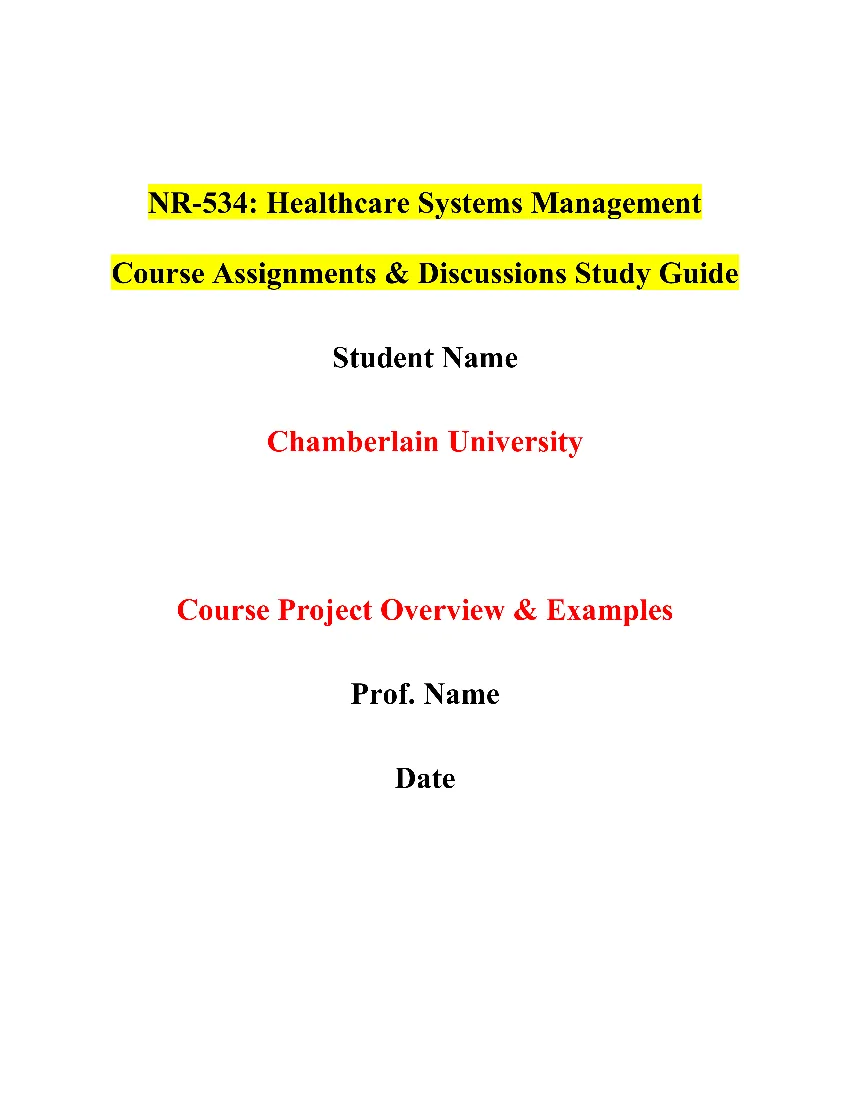 NR-534: Healthcare Systems Management Course Description
NR-534: Healthcare Systems Management Course Description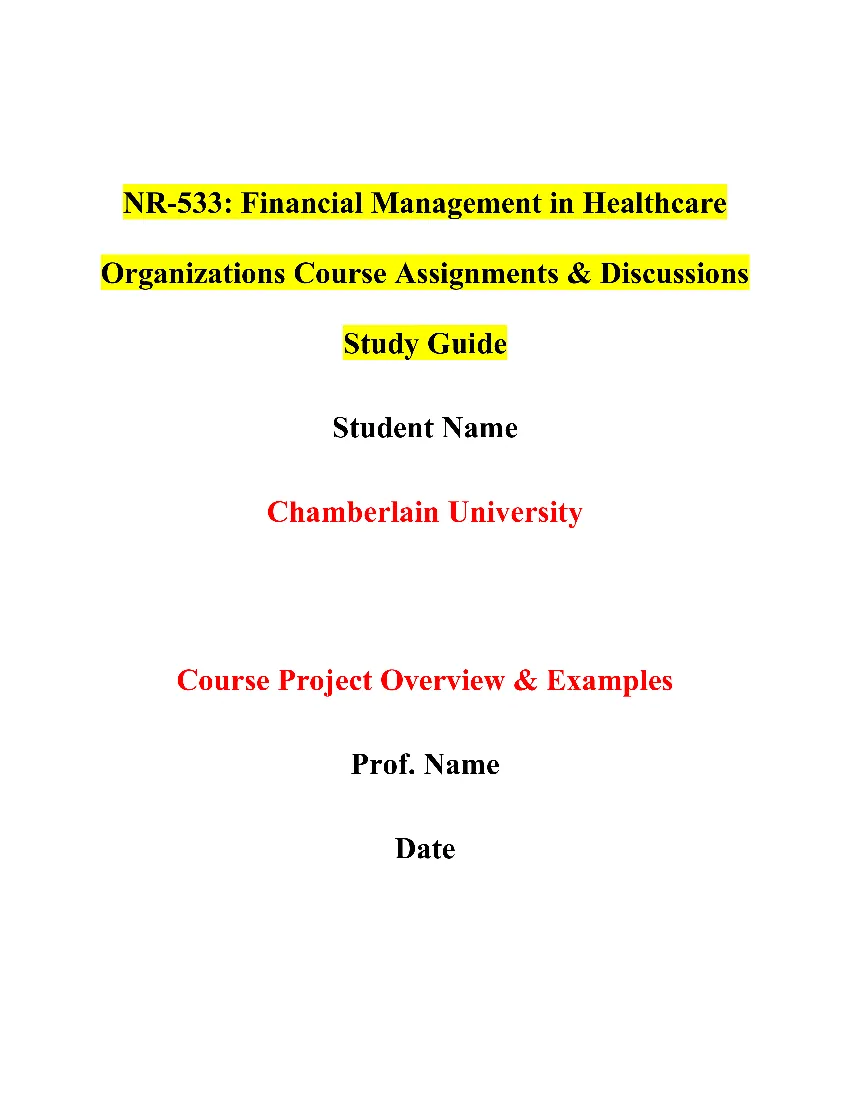 NR-533: Financial Management in Healthcare Organizations Course Description
NR-533: Financial Management in Healthcare Organizations Course Description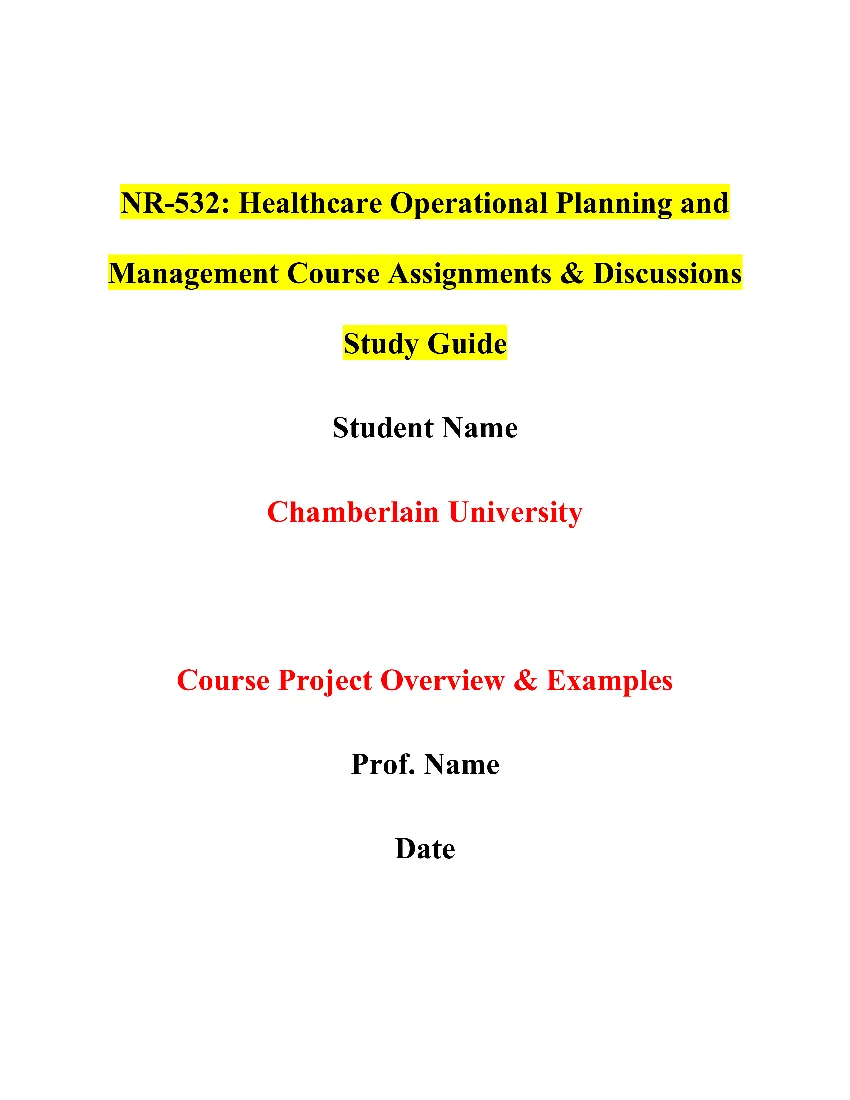 NR-532: Healthcare Operational Planning and Management Course Description
NR-532: Healthcare Operational Planning and Management Course Description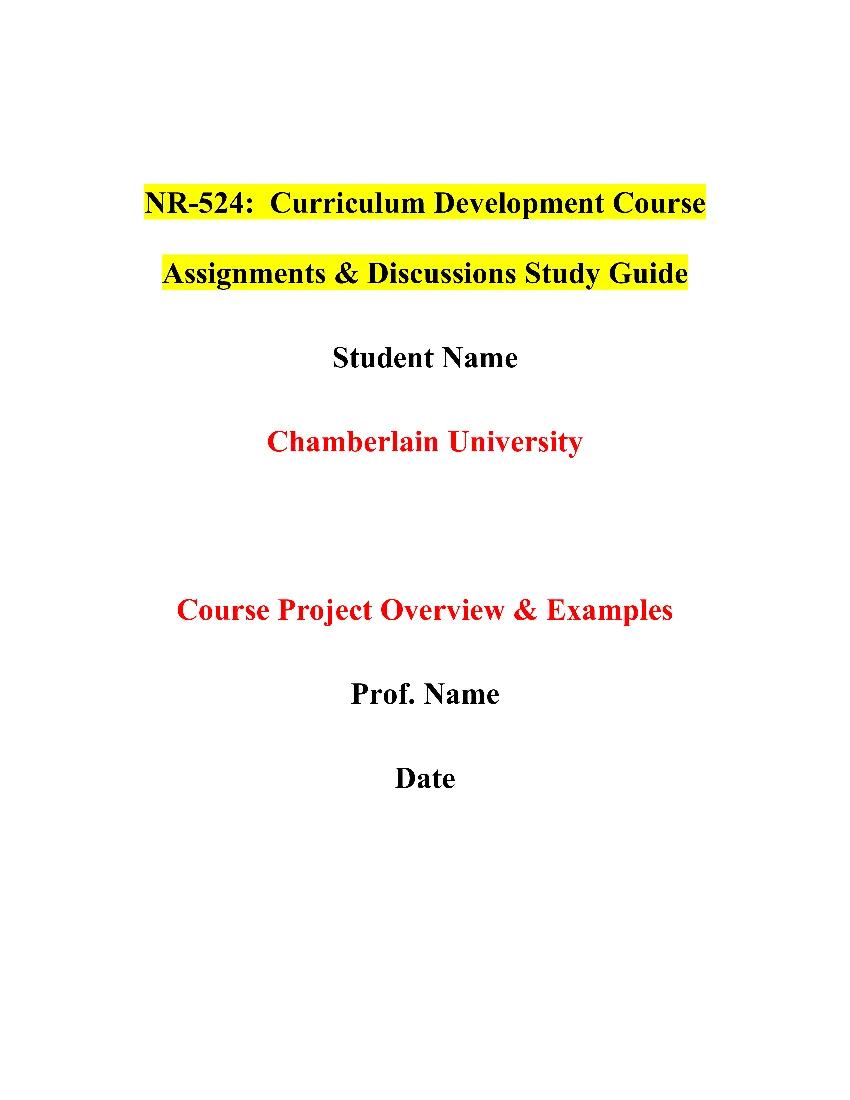 NR-524: Curriculum Development Course Description
NR-524: Curriculum Development Course Description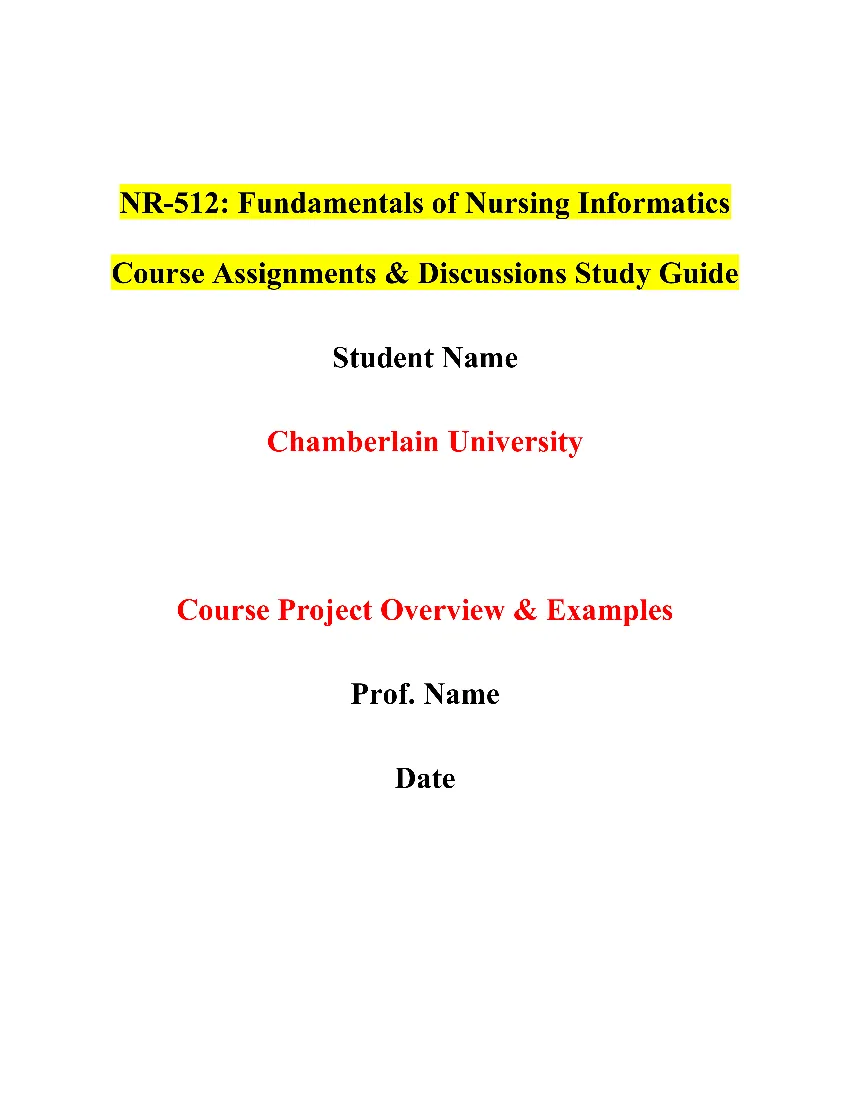 NR-512: Fundamentals of Nursing Informatics Course Description
NR-512: Fundamentals of Nursing Informatics Course Description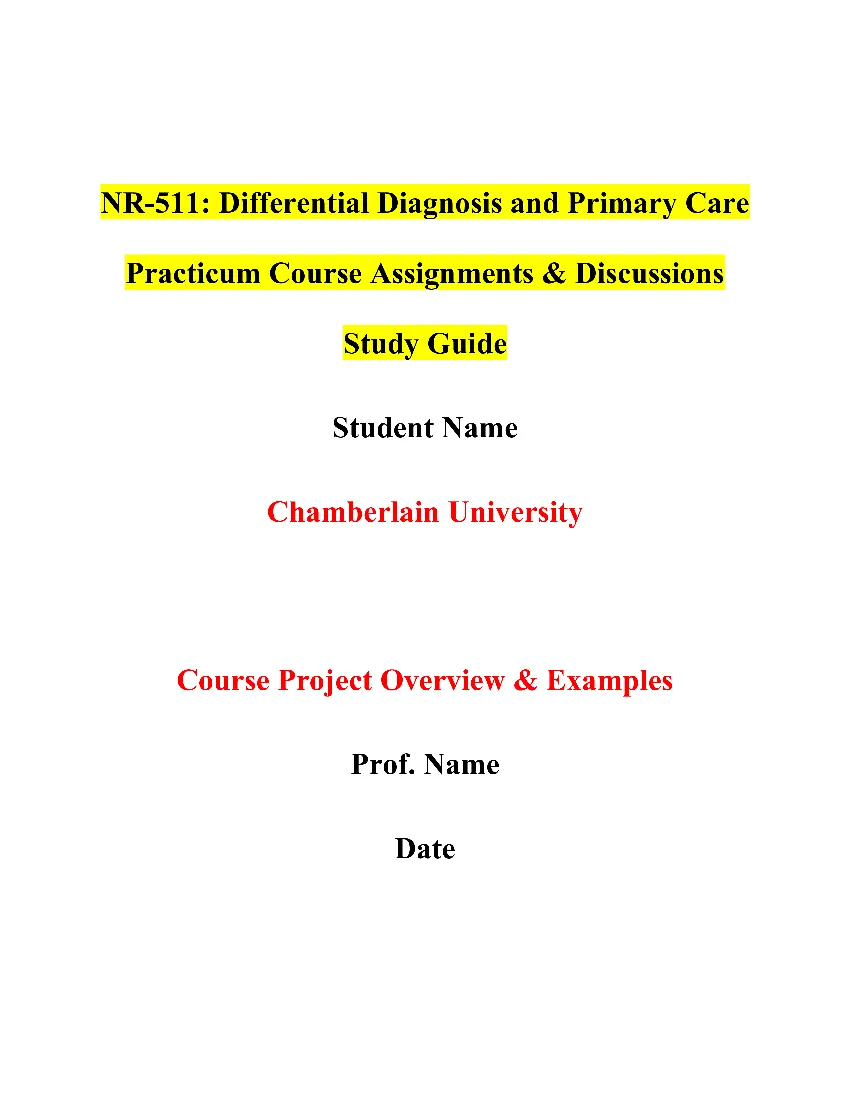 NR-511: Differential Diagnosis and Primary Care Practicum Course Description
NR-511: Differential Diagnosis and Primary Care Practicum Course Description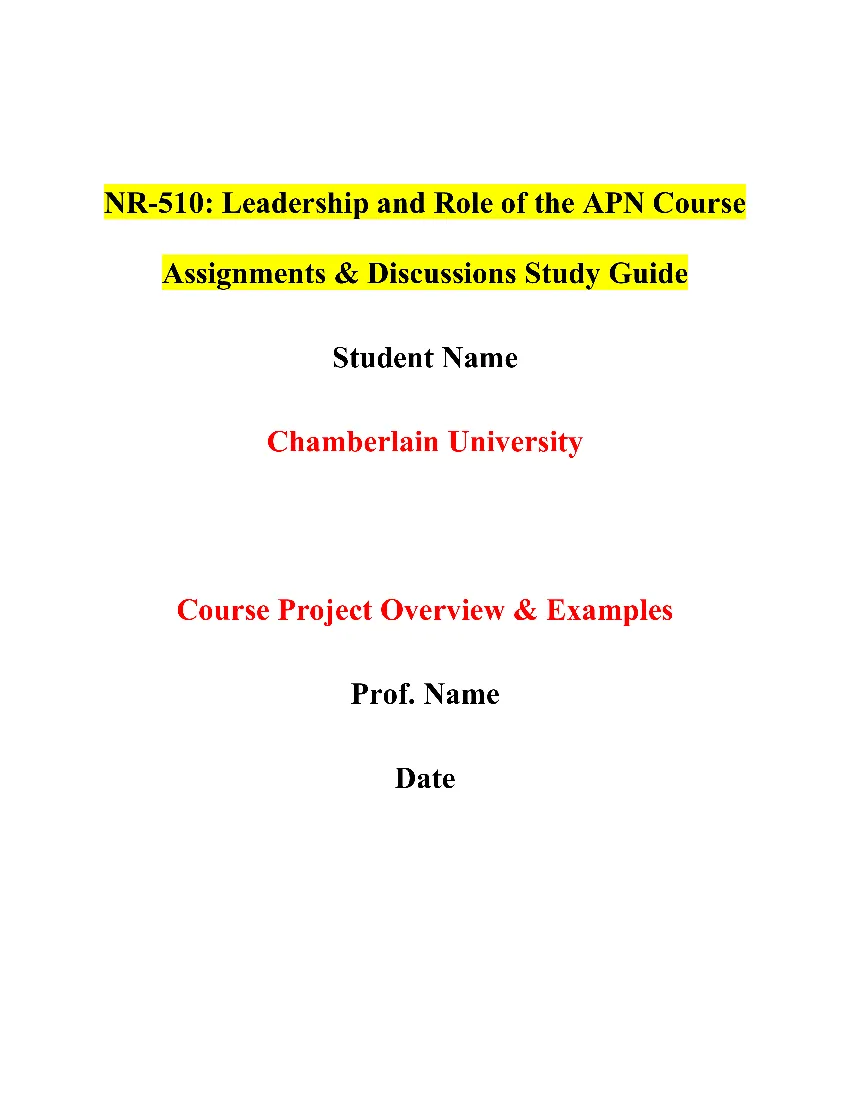 NR-510: Leadership and Role of the APN Course Description
NR-510: Leadership and Role of the APN Course Description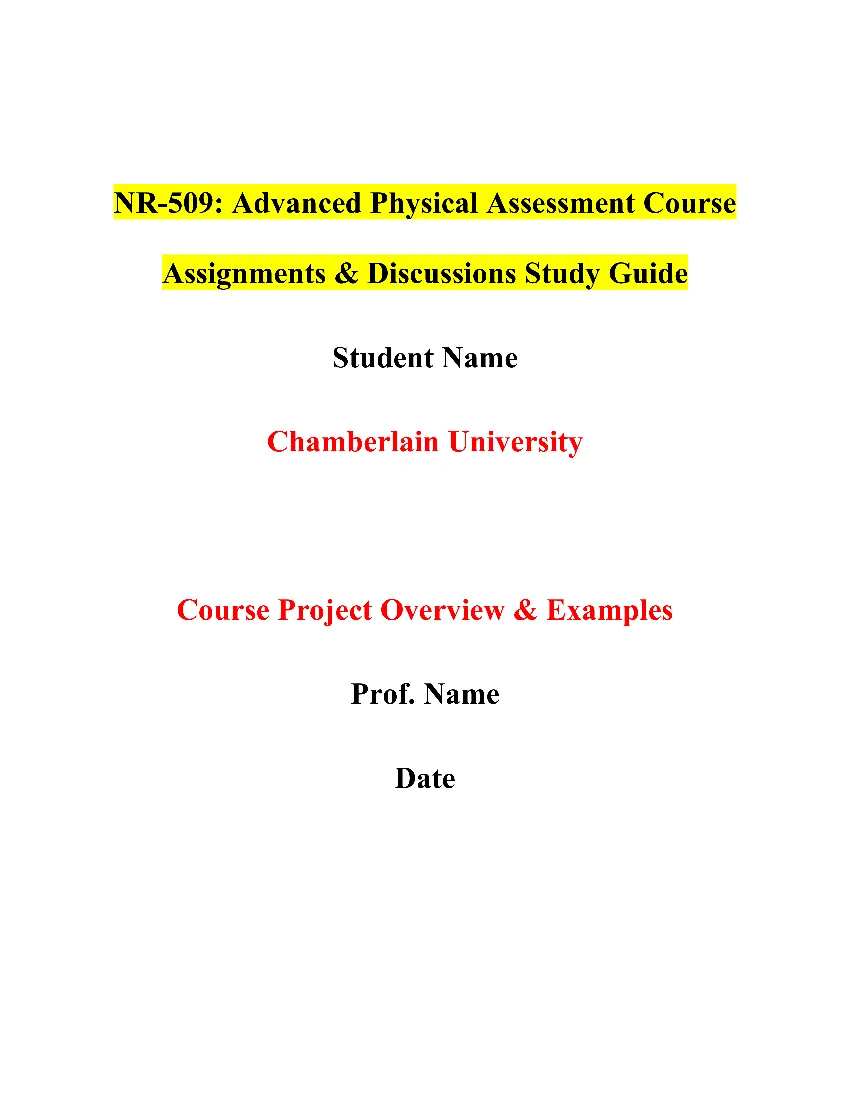 NR-509: Advanced Physical Assessment Course Description
NR-509: Advanced Physical Assessment Course Description